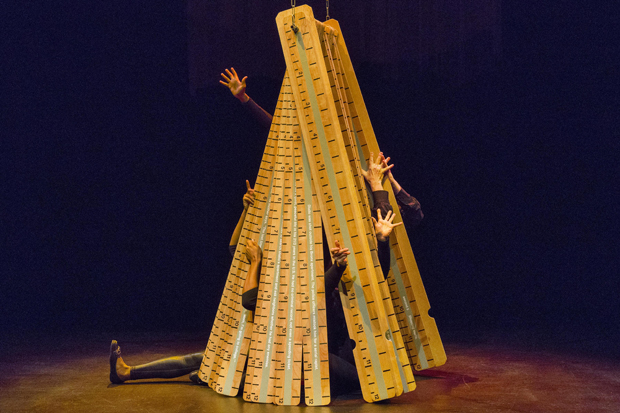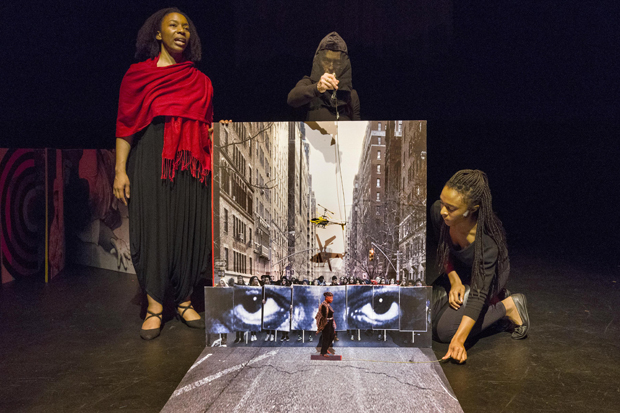Black Lives and Grieving Mothers in There's Blood at the Wedding

(© Richard Termine)
A woman mourns in the first scene of Federico García Lorca's Blood Wedding. Her young son is getting married and it should be a happy day, but she cannot banish the memory of her husband and older son, both of whom were violently killed. She also fears that it will happen again. Lest you think that such lingering dread is a relic of rural Spanish life in a bygone age, writer-director Theodora Skipitares is here to disavow you of that notion in her new play at La MaMa, There's Blood at the Wedding: Black mothers fear for the lives of their sons every day.
Skipitares engaged in a similar theatrical synthesis with her 2014 play, The Chairs, which used Ionesco as a platform for some of the most provocative thinkers of the century. Here, through her outsized and fantastical puppet design, Skipitares stages a very abridged version of Lorca's play to frame the stories of six individuals killed by the police: Sean Bell, Philando Castile, Sandra Bland, Amadou Diallo, Eric Garner, and Justine Damond. Like Lorca, Skipitares finds resonance in the rage and grief of their mothers.

(© Richard Termine)
The Blood Wedding puppets are classic Skipitares (like three-dimensional Picasso paintings, the giant faces of the mother and son are particularly striking). But she has devised a new creation called a performing book to tell the six main stories. Beautiful and impressively rendered, these giant pop-up books unfold to tell each story while the performers activate the moving parts. Each design is different and personalized, adding to our sense of not only the individual, but also how their story has been conveyed through the media.
For instance, the Book of Amadou Diallo looks like a drafting fan. The performers pull out and display each ruler as they list some key numbers about this model immigrant: five times he daily prayed, $9,000 he saved for college, zero marks on his criminal record, 41 bullets fired into his body. By the end, the performers burrow into this fan like children hiding in hanging blinds, raising some very serious questions: Do we hide the fundamental injustice of every death in the cold measurements of meritocracy? Is it more of a tragedy when someone deemed a "productive member of society" is murdered? The play is most effective when it is simply telling these stories and making us reevaluate how we process them.

(© Richard Termine)
Unfortunately, There's Blood at the Wedding too often falls into the experimental theater trap of smothering already compelling content in layers of form. In addition to her extraordinary puppets, Skipitares has incorporated modern dance and video design. Composer Sxip Shirey underscores the play with almost continuous live music. And while some of it is essential (like a bouncy pop ditty for a wedding scene), it regularly transforms the serious tone of the piece into something closer to melodrama.
Skipitares has also neglected some of the basics in her direction, making this 60-minute piece feel surprisingly sluggish. Many of the lines sound clunky, while the blocking comes off as wooden and unpolished. Bizarrely, Tom Walker reads almost every line as if he's channeling the ghost of Vincent Price, a bold choice for such horrific tales, but one that ultimately pulls focus. While she holds some of her characters at arm's length, Onome is much more successful at making a connection though her powerful vocal performance. Meanwhile, puppeteer and narrator Eric Lawrence Taylor radiates angst throughout, which feels appropriate for a play in which deadly force hides behind every badge and flashing light.

(© Richard Termine)
Not everything about There's Blood at the Wedding works, but the piece is nevertheless an important reminder of how pervasive violence is — and always has been. Lorca himself was shot and killed at the outset of the Spanish Civil War in circumstances that remain hazy to this day. A century later, such shadows of doubt are the reason why none of the police officers involved in the shooting described have been convicted of any crimes.










